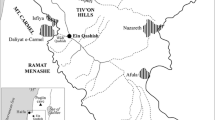Summary
Examination of eroded and intact earth mounds in the Clanwilliam district, South Africa, indicates that they are well-established active termitaria of the harvester termite Microhodotermes viator. Unoccupied lower portions of the mounds contain ubiquitous trace-fossil evidence of earlier inhabitation by the same species. Previous studies indicating that fossorial molerats played a major role in the formation of the mounds are not supported by the observations presented here. Calcretization of the basal parts of the earth mounds has been caused by groundwater interaction with the more alkaline mound soil. 14C dating of this calcrete indicates that the earth mounds have been in existence for at least 4000 years, an order of magnitude greater than any previously recorded longevity for termitarium inhabitation.
Similar content being viewed by others
References
Aten LE, Bollich CN (1981) Archaeological evidence for pimple (prairie) mound genesis. Science 213:1375–1376
Berg AW (1990) Formation of Mima mounds: a seismic hypothesis. Geology 18:281–284
Burgers CJ (1975) “Heuweltjies” (kraaltjies) in die Westelike Provinsie. Unpubl Report Cape Dept Nature Conservation
Campbell BM (1985) A classification of the mountain vegetation of the fynbos biome. Mem Bot Surv S Afr 50:1–119
Coaton WGH (1958) The Hodotermitid harvester termites of South Africa. Dept Agric Union S Afr Sci Bull 375
Coaton WGH (1962) Control of hodotermitid harvester termites in the Karoo. J Ent Soc S Afr 25:318–328
Coaton WGH (1981) Fossilised nests of Hodotermitidae (Isoptera) from the Clanwilliam district, Cape Province. J Ent Soc S Afr 44:79–81
Coaton WGH, Sheasby JL (1972) Preliminary report on a survey of the termites (Isoptera) of South West Africa. Cimbebasia Mem 2:1–129
Cockcroft MJ, Wilkinson MJ, Tyson PD (1987) The application of a present-day climatic model to the late Quaternary in southern Africa. Climatic Change 10:161–181
Cox GW (1984) The distribution and origin of Mima mound grasslands in San Diego County, California. Ecology 65:1397–1405
Cox GW, Gakahu CG (1983) Mima mounds in the Kenya highlands: significance for the Dalquest-Scheffer hypothesis. Oecologia 57:170–174
Cox GW, Gakahu CG (1984) Mima mounds in the Kenya Highlands: a test of the Dalquest-Scheffer hypothesis. J Mamm 65:149–152
Cox GW, Gakahu CG (1985) Mima mound microtopography and vegetation patterns in Kenyan savannahs. J Trop Ecol 1:23–36
Cox GW, Lovegrove BG, Siegfried WR (1987) The small stone content of Mima-like mounds in the South African Cape region: implications for mound origin. Catena 14:165–176
Darlington JPEC (1985) Lenticular soil mounds in the Kenya highlands. Oecologia 66:116–121
Davies KC, Jarvis JUM (1986) The burrow systems and burrowing dynamics of the mole-rats Bathyergus suillus and Cryptomus hottentotus in the fynbos of the south-western Cape, South Africa. J Zool Lond (A) 209:125–147
Du Toit AL (1954) The Geology of South Africa. Oliver and Boyd, Edinburgh
Embelton C, King CAM (1975) Periglacial Geomorphology. Edward Arnold, London
Fernandez LM, Guzman JA (1979) Earthquake hazard in southern Africa. Geol Surv S Afr Seismol Series 10
Gakahu CG, Cox GW (1984) The occurrence and origin of Mima mound terrain in Kenya. Afr J Ecol 22:31–42
Hesse PR (1955) Chemical and physical study of the soils of termite mounds in East Africa. J Ecol 43:449–461
Knight RS, Rebelo AG, Siegfried WR (1989) Plant assemblages on Mima-like earth mounds in the Clanwilliam district, South Africa. S Afr J Bot 55:465–472
Lee KE, Wood TG (1971) Termites and Soils. Academic Press, London
Lovegrove BG, Siegfried WR (1986) Distribution and formation of Mima-like earth mounds in the western Cape Province of South Africa. S Afr J Sci 82:432–436
Lovegrove BG, Siegfried WR (1989) Spacing and origin(s) of Mima-like earth mounds in the Cape Province of South Africa. S Afr J Sci 85:108–112
Martin GHG (1988) Mima mounds in Kenya — a case of mistaken identity. Afr J Ecol 26:127–133
Merryweather FR (1965) The soils of the Wellington-Malmesbury area. Unpubl MSc (Agric) thesis, Univ Stellenbosch
Midgley GF, Musil CF (1990) Substrate effects of zoogenic soil mounds on vegetation composition in the Worcester-Robertson valley, Cape Province. S Afr J Bot 56:158–166
Milton SJ, Dean WRJ (1990) Mima-like mounds in the southern and western Cape: are the origins so mysterious? S Afr J Sci 86:207–208
Okello-Oloya T, Spain AV, John RD (1985) Selected chemical characteristics of the mounds of two species of Amitermes (Isoptera, Termitinae) and their adjacent surface soils from northeastern Australia. Rev Ecol Biol Sol 22:291–311
Okwakol MJN (1987) Effects of Cubitermes testaceus (Williams) on some physical and chemical properties of soil in a grassland area of Uganda. Afr J Ecol 25:147–153
Pomeroy DE (1983) Some effects of mound-building termites on the soils of a semi-arid area of Kenya. J Soil Sci 34:555–570
Semeniuk V, Meagher TD (1981) Calcrete in Quaternary coastal dunes in southwestern Australia: a capillary-rise phenomenon associated with plants. J Sedim Petrol 51:47–68
Slabber MH (1945) 'n Grondopname in die Malmesbury-Piketberg streek. Unpubl DSc (Agric) thesis, Univ Stellenbosch
Ten Cate H (1966) Die gronde van die Overhex-Nuy gebied naby Worcester. Unpubl MSc (Agric) thesis, Univ Stellenbosch
Tyson PD (1986) Climatic change and variability in southern Africa. Oxford University Press, Cape Town
Van der Merwe CR (1940) Soil groups and subgroups of South Africa. Dept Agric Union S Afr Sci Bull 231
Visser HN, Toerien DK (1971) Die geologie van die gebied tussen Vredendal an Elandsbaai. Geol Surv S Afr Expl Sheets 3118C and 3218A
Vogel JC (1970) Groningen radiocarbon dates IX. Radiocarbon 12:444–471
Vogel JC (1982) The age of the Kuiseb River silt terrace at Homeb. Palaeoecol Afr 15:201–209
Watson JP (1967) A termite mound in an Iron Age burial ground in Rhodesia. J Ecol 55:663–669
Watson JP (1974) Calcium carbonate in termite mounds. Nature 247:74
Author information
Authors and Affiliations
Rights and permissions
About this article
Cite this article
Moore, J.M., Picker, M.D. Heuweltjies (earth mounds) in the Clanwilliam district, Cape Province, South Africa: 4000-year-old termite nests. Oecologia 86, 424–432 (1991). https://doi.org/10.1007/BF00317612
Received:
Accepted:
Issue Date:
DOI: https://doi.org/10.1007/BF00317612




